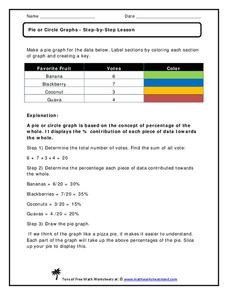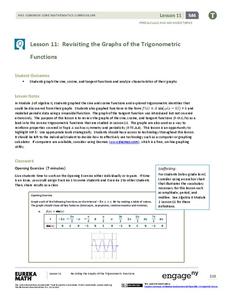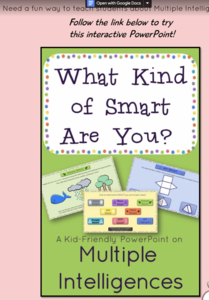Curated OER
Equivalence and Comparing Fractions
Each of these five models represents one of the fractions listed; challenge your scholars to match them up. The models consist of shapes divided into squares with the total number of squares as the denominator and a colored portion as...
Curated OER
Understand Categories of Shapes
This colorful set of shapes and figures is the data set learners need to fill out an extensive table. For each of 11 types of shapes or figures they record the quantity and how many corners and sides each has. This becomes more difficult...
Curated OER
Understanding Categories of Shapes
What are these shapes? Scholars match seven shapes to their names: rhombus, sphere, square, cone, circle, triangle, and parallelogram. Although there isn't much to this worksheet, the shapes are nicely colored and it would...
Balanced Assessment
Red Dots, Blue Dots
Count the connections between dots. Young mathematicians come up with a method to determine the number of connections between pairs of dots. The assessment leads the class to determine the connections they can make when groups are...
Howard Hughes Medical Institute
Color Variation over Time in Rock Pocket Mouse Populations
A species-specific look at natural selection, the resource herein examines how adaptations have helped the population of rock pocket mice survive in a changing landscape. To begin, middle or high schoolers watch a 10.5 minute video,...
Math Worksheets Land
Pie or Circle Graphs—Step-by-Step Lesson
How do you display data that you've collected in a pie chart? Follow a clear step-by-step guide to turning survey results into a visible format. It shows kids how to determine the percentage of the whole that each section represents.
Wise Owl Factory
Happy Father's Day
Celebrate Father's Day this year with a fun math and coloring activity! After counting all of the dad-related pictures and graphing their frequency, learners color a Father's Day card to give to their dads.
EngageNY
Tangent Lines and the Tangent Function
Construct tangent lines and make the connection to tangent functions. An informative lesson reviews the geometry origins of the tangent function. Pupils use that information to determine how to construct a tangent to a circle from a...
EngageNY
Three-Dimensional Space
How do 2-D properties relate in 3-D? Lead the class in a discussion on how to draw and see relationships of lines and planes in three dimensions. The ability to see these relationships is critical to the further study of volume and...
EngageNY
Justifying the Geometric Effect of Complex Multiplication
The 14th lesson in the unit has the class prove the nine general cases of the geometric representation of complex number multiplication. Class members determine the modulus of the product and hypothesize the relationship for the...
EngageNY
Matrix Notation Encompasses New Transformations!
Class members make a real connection to matrices in the 25th part of a series of 32 by looking at the identity matrix and making the connection to the multiplicative identity in the real numbers. Pupils explore different...
EngageNY
When Can We Reverse a Transformation? 3
When working with matrix multiplication, it all comes back around. The 31st portion of the unit is the third lesson on inverse matrices. The resource reviews the concepts of inverses and how to find them from the previous two lessons....
EngageNY
Revisiting the Graphs of the Trigonometric Functions
Use the graphs of the trigonometric functions to set the stage to inverse functions. The instructional activity reviews the graphs of the basic trigonometric functions and their transformations. Pupils use their knowledge of graphing...
Curated OER
Most Likely/Least Likely
Learners consider a practice problem which prompts them to choose the type of marble most likely to be picked out of a group. Then, they answer probability-type questions regarding a spinner, and a tally chart of coins.
Curated OER
Patterns in the Multiplication Table
Explore patterns in the multiplication table in order to deepen your third graders' understanding of this essential skill. Implement this activity as a whole-class lesson, allowing students to work in pairs or small groups to support...
Teachers Pay Teachers
What Kind of Smart Are You
Gain insight into the type of learners that fill your classroom. An eight-question survey asks scholars questions about themselves. Using their color-coded answers, they conclude their degree of intelligence in multiple areas—music,...
Sunday School Resources
Noah & the Ark
Support your study of Noah's Ark with these materials. Included here are word puzzles, coloring pages, math exercises, and more, all related to Noah's Ark.
West Contra Costa Unified School District
Adding by finding 10's
Count with ten frames in a first grade addition lesson. Kids determine how to identify numbers on a number line, as well as with ten frames, and complete ten frames to show their answers in several addition problems.
Curated OER
Jelly Bean Math
In this Easter math worksheet, 1st graders work with a handful of jelly beans. Students sort the jelly beans by color and color in one block of the color graph per jelly bean.
Curated OER
Congruent Coloring
In this mathematics worksheet, 1st graders find the pairs of polygons that are congruent on the sheet. Then they color them the same color and use their ruler to check their selections.
Curated OER
Bug Puzzle Coloring Page & Connect the Dots
In this math and coloring worksheet, learners practice counting to 30 by completing a dot to dot puzzle. Students color the picture of bugs carrying a large object to their anthill.
Curated OER
Sort and Color: 100 Bears
For this math worksheet, students sort the colors of gummy bears in the hands on activity. Then they color the bears on the sheet.
Curated OER
Number 9 Coloring Page
In this color by number coloring worksheet, students fill in portions of the puzzle using the number/color key at the bottom of the page. They see the number 9 surrounded by crayons when the picture is complete.
Curated OER
Colorful Cups
In this counting practice worksheet, students use the colors red and blue to color each set of cups to show the partners and the switched partners for each number. Students write the partners and the switched partners.
Other popular searches
- Coloring Math
- Math Coloring Sheets
- Coloring Math Activity
- Map Coloring Math
- Math Coloring Worksheets
- Coloring Math Generator
- Christmas Coloring Math
- Math Coloring Pages
- Code Math Coloring
- Spring Coloring Sheets Math
- Math Coloring Puzzles
- Math Coloring Multiplication























